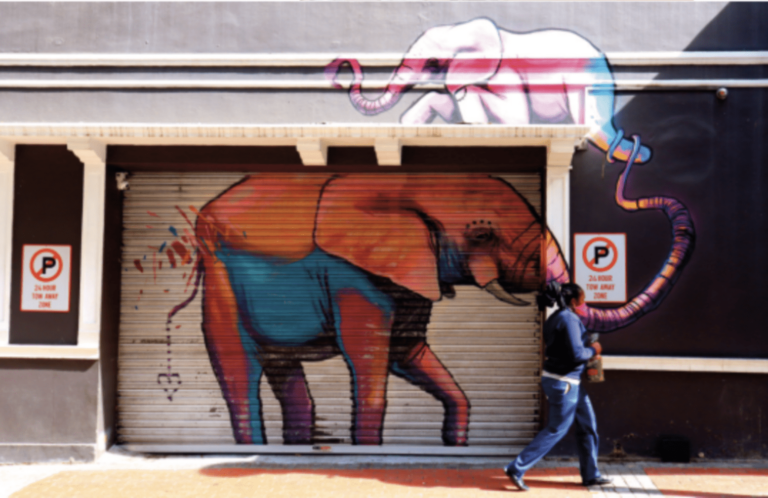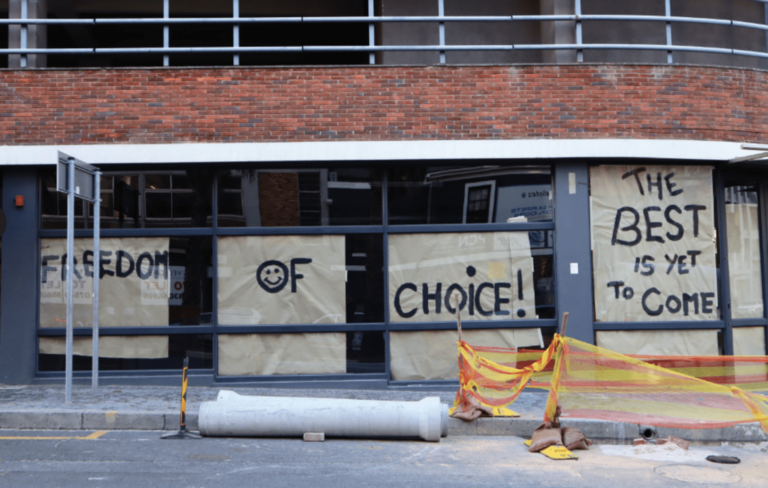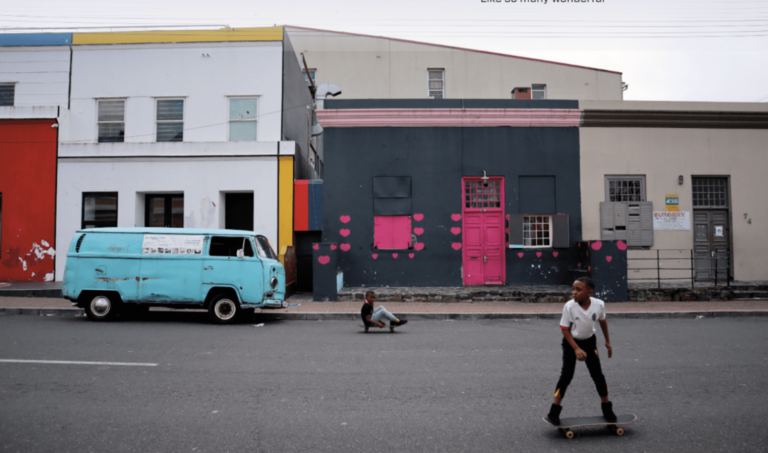[ad_1]
Hobnobbing with strangers is such a jol, writes Keith Bain, who finds that there are plenty of people on the side- and back streets of Cape Town ready to stop for a chat.
In front of the South African National Gallery on the concourse overlooking Cape Town’s Company’s Garden, landscape artist Jacques Viljoen was holding his thumb at arm’s length above his easel, gauging how to fit Table Mountain onto his canvas.
This 19th-century French Impressionist in a paint-spattered puffer jacket, jeans and peak cap was among my discoveries during a recent quest to get lost down the back alleys of the city in which I’ve been wandering about aimlessly for years.
I’d spotted Jacques hanging pictures ahead of a First Thursdays exhibition. They were timeless scenes from across the Cape, painted since the pandemic compelled him to return to South Africa after 10 years abroad. It thrilled him, he said, that the previous day he’d painted Signal Hill’s kramat, while today a synagogue’s dome foregrounded his mountainscape.

Watching him paint, I noticed what pleasure there was to be had from immersing yourself in a scene, getting lost in the reality of a single frame to capture its essence. It was, I thought, a technique not unlike my own urban explorations, habitually losing myself on pavements and side streets to get at a city’s pulse – a practice the French call flâner, aimless wandering which for some is meditation, getting lost with intention, tumbling down the rabbit hole, directionless yet determined. A procedure of stumbling into places, asking strangers for directions, or making conversation about… well, the topics don’t matter.
Every second person I bumped into came from somewhere else. There was the shy Bangladeshi in the black leather jacket who hangs out in the Garden after working in his brother’s grocery store; the Somali Uber driver who vetoed my suggestion that should he marry a South African because, as he put it, ‘it would lead to a lot of complications’; and Diana Viola, the Malawian shawarma whisperer at the Nish Nush hummus hatch on Riebeek Square who told me her politeness was nothing special. ‘I was raised to be friendly to strangers, that’s all,’ she said.
Everyone had a story. Even the 22-year-old Zimbabwean barista with dreams of being a big-shot amapiano star who claimed he’d happily be the last person in Cape Town to get vaccinated. I figured it was youthful pride and gave him a long lecture as though I knew any better.
The less I assumed I knew, though, the easier it was to lose myself, to dislodge familiar patterns. Like some sort of idiot savant I travelled on impulse, stuck my head into open doorways, peered through windows, stared stupidly at street names waiting for someone to pose the inevitable: ‘You lost?’
I heard brass bands hammering out festive tunes in upstairs karate studios that, on Sundays, transformed into churches for immigrants from faraway corners of Africa. I saw barbers smoking fiercely during their breaks between clients who seemed to form inexhaustible queues for a trim. The surge on hairdressers and shisha lounges and Banting-be-damned bakeries was a contrast to the proliferation of “To Let” signs spawned by the pandemic.

There were lonelier streets, too. Melancholic scenes where groups of men huddled outside round-the-back doorways on side roads lined with second-hand motorbikes. These, they told me, were “dark kitchens”, suppliers of take-away meals without sit-down space. Yet another strange pandemic phenomenon.
On Shortmarket Street, I took heed of the sign in the window of House of Machines imploring passers-by to be decent: “Don’t be a dick,” it says; words to live by. Around the corner, one of the city’s in-his-own-world outjies was yelling to anyone who’d listen, telling the traffic to stuff off in even more colourful language than another bloke – one who didn’t have a soapbox but was hell-bent on making his politics known to the world, finger aloft, pissed off.
As I pounded the pavements, I noticed how the antique architectural layers – baroque cupolas, Gothic steeples, stained-glass windows, Cape Dutch this, art deco that – rubbed up against the brutalist monstrosities. And how these disparities were softened by the whimsical renderings of modern-day muralists, such as Falko One, whose friendly elephants pop up across the city. Or Belgian street artist Bart Smeets’s humungous jack russell aviator, originally painted to advertise Baz-Art’s 2019 International Public Art Festival. Now the doe-eye pup keeps watch over Harrington Street’s rambunctious hipster re-gearing.
Under his eye, a place that’s fun to get lost inside is Surfa Rosa, with its vintage-meets-punk atmosphere (and stuffed crocodile) upstairs. I stuck my head in the alleyway at the main entrance and ventured in and made like I was in a scene from a Bond movie where 007 is being chased through a Chinese restaurant, fighting hoods armed with pots and pans and boiling water.
Okay, not quite. Instead, I got a smile and a wave and a chuckle from someone making a sandwich in the kitchen of The Electric, a reinvented auto-electrics workshop transformed into a community-minded café after it was gutted by fire.
There were more of these semi-cinematic moments hidden down unexpected side streets. The Art of Duplicity is a speakeasy-themed bar on an East City back alley named Coffee Lane in a renovated 1894 Victorian warehouse. Tucked into the backside of coffee evangelist David Donde’s steampunk-styled Truth coffee shop on Buitenkant Street, the drinking establishment references Prohibition – you enter with a password and are urged to dress up. The idea is to get lost – not just in the spirits, but in the spirit of the place, the make-believe with its low-lighting, vintage counter, and seating between the coffee sacks.
Many of Cape Town’s 30-odd lanes and alleyways – meant to provide pedestrians with a link between larger roads – long ago went to seed or became no-go zones, some even got gated barriers or were turned into parking lots. In 2014, as part of Cape Town’s World Design Capital tenure, there was a flourishing of efforts to revive and democratise these forgotten side streets. Several became sites for community gatherings – “street yoga”, neighbourhood lunches, open-air film screenings, ideas inspired by booming street culture in cities such as Berlin and Melbourne.
A more recent, and sustained, intervention is the alleyway wedged between two buildings adjacent Harrington’s old-school barber shop, in the building made to look like a Victorian-era apothecary.
Step off the pavement and – lo and behold – instead of a roach-infested bin alley, it’s done out with colourful murals, tables and benches, and overflowing plants. And everyone’s welcome. There’s a food truck and a side entrance to Nude. Not a strip club, but a store eschewing single-use packaging. Its shelves invite you to forage for pay-by-weight nuts and siphon virgin olive oil from barrels into glass canisters.
Venturing north, crossing Roeland Street at the gallery where I found Jacques the painter, I found myself in a seemingly deserted pocket of the city; pin-drop quiet, barely a soul in sight. Rusted fencing cordoned off a weed-speckled lawn, huge murals turned dilapidated buildings into storyboards, and along the pavements, a small homeless community had erected makeshift quarters using other peoples’ discards.
I took a right, left, right again, and was back on familiar turf: motley, semi-industrial Roodehek Street, where a dishevelled warehouse once served as a coffee roastery attached to the best espresso counter for miles. Today, Yard, as it’s known, continues in that same, grungy, “make-it-work” tradition. Its beer-sticky tables, junk-store decor and raw-brick trimmings serve as a venue known for gourmet pizzas and burgers and waitresses with take-no-shit attitudes.
‘What are those?’ I asked mine as she plonked down a huge peanut-butter milkshake. ‘Oh, the shower curtains? That was our Covid strategy,’ she shook her head as if to rid it of a bad memory. ‘Cute idea, but we only used them, like, once. People want to see each other. You can’t make eye contact with strangers if there’s a curtain between the tables.’
Back outside, over the grunts from the upstairs Pride Fighting Academy, I heard him before I saw him: a guy with a swagger and bright yellow trainers, music blasting from his cellphone so loudly it could be heard three blocks away. Bad-ass hip-hop, kwaai vloekwoorde (fierce swear words) resounding off the buildings.
I made to intercept him and he gave me a standoffish stare. ‘What’s the song?’ I asked.
‘Who knows?’ he retaliated, ready to parry. ‘I’m only playing it so people won’t bother me. Ma’ dis fokken lekker, nê (But it’s f*cking nice, not so)?’
The irony of the exchange was lost on neither of us; even as the words exited his mouth, his street-forged hardness melted into a full-body smile, and then he gyrated his hips in a gravity-defying dance that suggested we weren’t entirely strangers any more.
Back outside the National Gallery, Jacques had told me he seldom paints in the city centre because there’s a chance of getting mugged. I realised I’d been recruited – as his security detail. Easy gig: Jacques was a magnet. Not for muggers, but for the kindness of strangers.
As he painted, impromptu audiences clucked their tongues approvingly, shook their heads as though they were witnessing a kind of miracle. In this age of Instagram and fleeting digital impressions, oil paint made a lasting impression.

‘That’s so nice, man!’ shouted a guy with a luminous pink backpack.
‘Aweh, brother!’ Jacques yelled back.
He told me Capetonians like to compliment. In London and Florence, everyone passes judgement. Here, though, appreciation is expressed. People don’t just glance – they turn, they walk sideways, perform U-turns to stop and watch.
A man clutching a Bible came in for a closer look. ‘It’s so good. Thank you! Thank you!’ he shouted, genuflecting as he backed away as if exiting a royal-audience chamber.
I watched him as he went and recognised something in his face that really touched me: delight. I made a silent promise to take that same capacity for awe and astonishment with me the next time I set off to get lost in the city. And to see what the effect might be of treating my own backyard with the deference of a visiting stranger.
Do it
Best way of getting to know a city? On foot. ‘A city is a language, a repository of possibilities,’ writes Rebecca Solnit in Wanderlust: A History of Walking Walkers, ‘and walking is the act of speaking that language. Architecture limits where one can walk, but the walker invents other ways to go.’
By walking you can get to grips with the heart and soul of a place, make it your own.
To level up, ditch the GPS and rather ask strangers. Stopping to chat to ordinary folk will open up your world, broaden your horizon.
Or just get lost. Be transported by the sights and sounds and sometimes not-so-fantastic smells. Dip in, dip out, turn on your heels, spin around, ignore the signs (except the ones with warnings), and walk in a direction you weren’t expecting to take. Just go, go, go… Hang on. Rookie error. Surely there are some side streets you want to avoid? Well, yes. Getting lost is an art, not an act of stupidity. So do watch out for what might be lurking in the shadows.
Follow us on social media for more travel news, inspiration, and guides. You can also tag us to be featured.
TikTok | Instagram | Facebook | Twitter
ALSO READ: Grubbs up: insects and food
[ad_2]
Source link
Jarastyle – #lost #purpose #Cape #Town
Courtesy : https://www.getaway.co.za/travel/adventures/getting-lost-on-purpose-in-cape-town/

